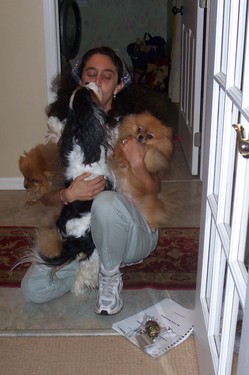Dog trainer Cheri Lucas: Owner's calm attitude, regular exercise can combat separation anxiety

Julia Levitt | Contributor
In my last post, we looked at what canine trainer Martin Deeley (who dog aficionados refer to as "the trainer's trainer") says about separation anxiety.
Before I give you another point of view from dog trainer, Cheri Lucas, let me introduce you to her.
Lucas began her work with dogs by working with Cesar Millan of the Dog Whisperer fame. Only when she began working with Millan, he was not the internationally known person he is today.
Years went by, and after working with Millan, Lucas was able to "go it" on her own. She started Second Chance at Love, a rescue organization for dogs, and currently lectures and gives training workshops throughout North America. Here is Lucas' point of view on separation anxiety.
As counterintuitive as it may seem, pups will feel more secure and have less anxiety when they view you as a leader rather than a lover. The energy you project to the puppy will determine how pups feel about their current situation. Primarily sharing an overly emotional, nervous or fearful energy with the pups will signal a "weakness" to them. Imagine how powerful the burden would be on a dog that he feels charged with the survival of his human pack. Fear and anxiety often develop when the dog realizes he's not equipped for the task he's been inadvertently given.
We often alleviate our anxieties while transferring it to out dogs.
Anne is an anxious person. She adopted Hal, a very sweet mixed breed. He wanted to please Anne and loves people. Anne though felt very guilty. She works long hours, and when she comes home she lavishes attention on Hal.
When Anne called me, her concern was that Hal did not want to go in his crate. What we found were the signals Anne was sending Hal, which created his concerns. Anne would use baby talk — high pitched talk — and plead with the dog to go in his crate. Then she would profusely apologize. Once the dog was in his crate and call out again in a high pitched voice "goodbye" as she left the house.
Anne would come home to a dog that had been gnawing on his crate, his mouth covered in foam. The bars of his crate bent from him chewing on them. This energy the dog feels from Anne as she puts the dog in his crate and leaves are not reassuring.
The calm confidence we project as we say the word "crate" calmly putting on our coat and slowly and quietly leaving the house adds volumes of reassurance when we leave the house.
The same is true when we come home. When we walk in the door, it's important to not look at the anxious dog or call out a greeting. After you have settled yourself, calmly walk to the crate — no eye contact — and when the dog is quiet, not pawing and whining to get out, only then does the door to the crate open.
Offer no verbal rewards for getting out of the crate. This is a not prison. Calmly walk away.
You will be surprised at how calmly your dog responds.
"Make sure your interactions with the pups are about more than affection suggests," says Lucas.
"Use calm deliberate and assertive energy when caring for a puppy. Introduce pups to crates, proceed slowly and patiently, gradually increasing time the pup spends crated every day. Crates are like dens for dogs in their natural world. They go a long way in helping a dog feel safe and secure."
Lucas stresses that the most important and probably the most difficult step will be for you to not make a big deal out of leaving or returning. If you go into an emotional state because you feel guilty about leaving the dog behind, they will sense something is wrong and act accordingly.
"Remember," Lucas continues, "that dogs are hardwired to keep the pack stable. As pack leader, it is your job to help a dog achieve that goal, while remaining calm and assertive."
Lucas lives these statements. Do we? How often do we take out our daily frustrations on our dogs? How often are we frustrated as we don’t know how to correct a problem?
I have been called into see dogs that people are very concerned about separation anxiety.
One of our readers from Washington State commented that my solution to problems are taking a dog for a walk. I have found that many issues can be alleviated with exercise. Every single dog I have worked with is under-exercised. It sounds so simple.
People come home from work and are tired and busy with their families. A dog that has been in a house all day is bursting with energy. Problems such as chewing and urinating in the home are symptoms of other issues. While we love our homes, to the dog, it is one big kennel. I cannot stress enough that dogs take time and responsibility.
"Exercise," Lucas concludes, "is a very important component in fulfilling a dog. Basic obedience training skills are a way to psychologically exercise a puppy — in addition to plenty of physical exercise. Presenting yourself as a calm assertive leader — giving the pups affection only when they are in a calm state of mind, you will be behaving as a true leader to your dog."
Julia Levitt is the founder of In Harmony Dog Training (www.inharmonydogtraining.com) in Ann Arbor. She can be reached at julia@inharmonydogtraining.com or at 734-645-4707. Julia provides individual training for dogs and their owners, and also conducts dog training classes at Ann Arbor Animal Hospital.

